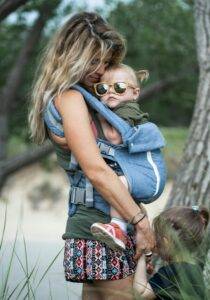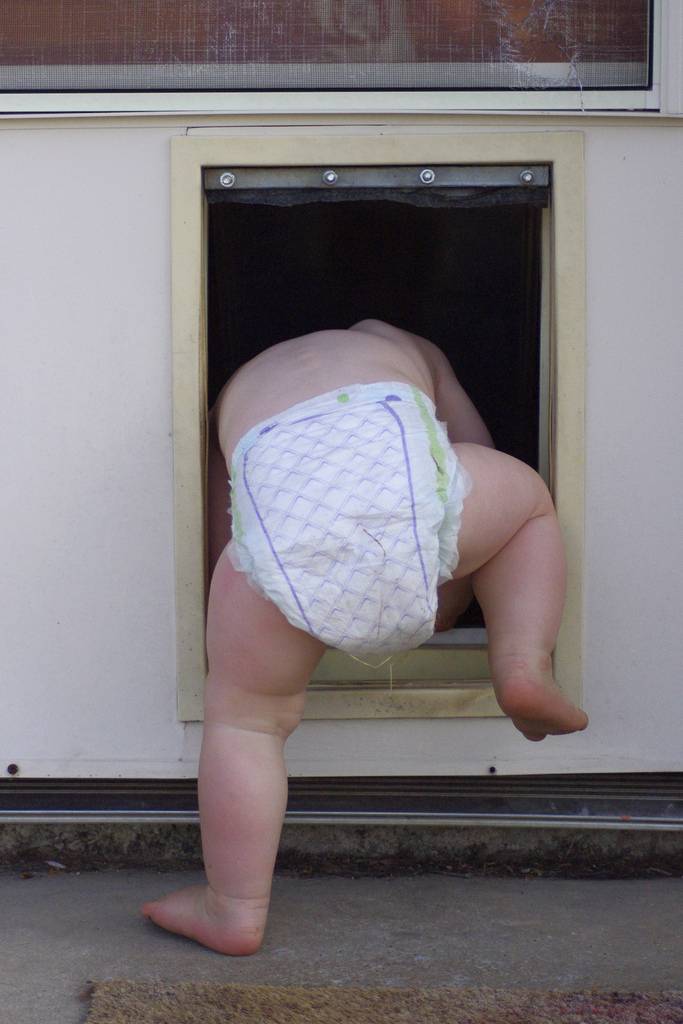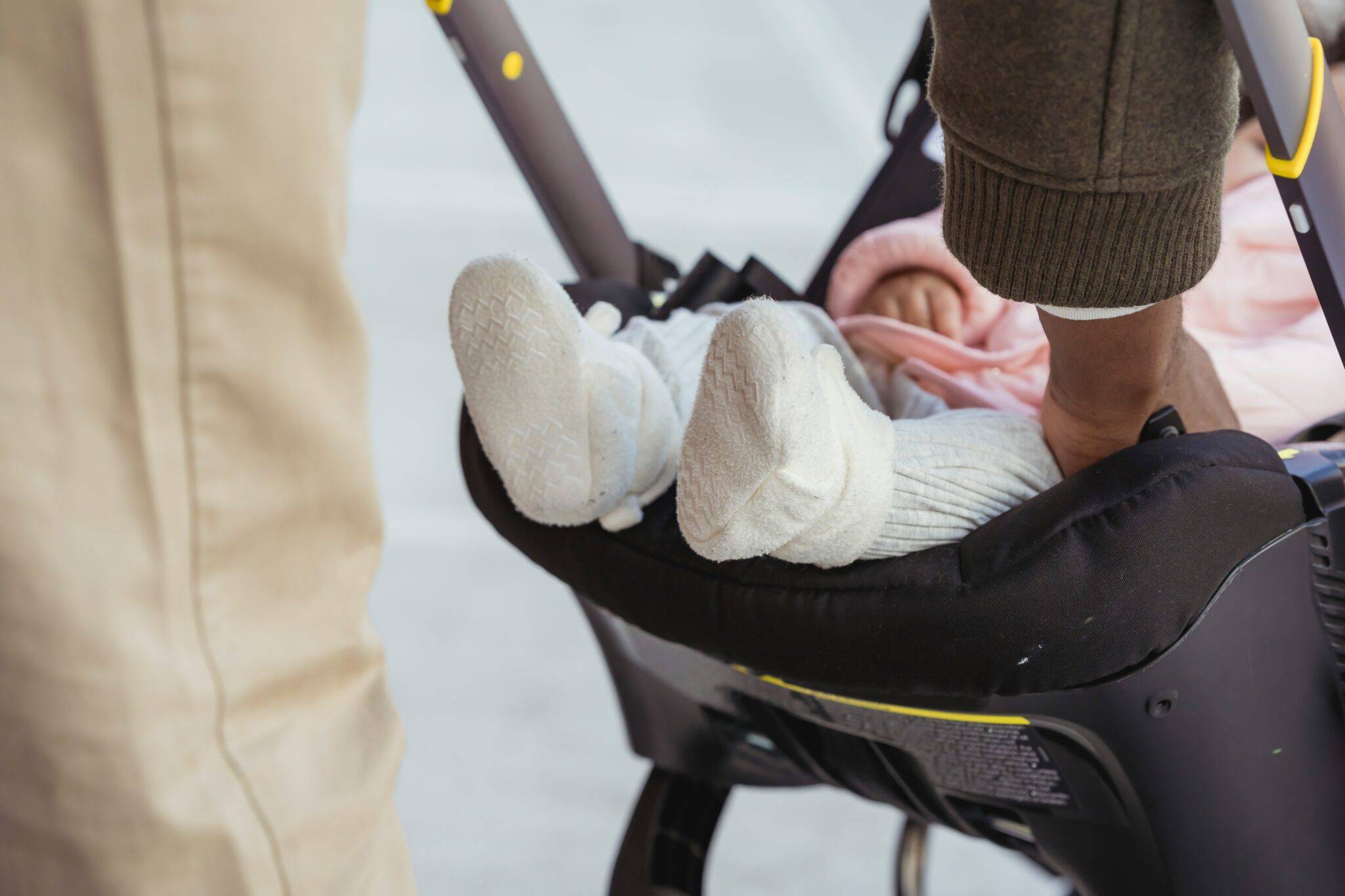Choosing the perfect newborn baby carrier is a transformative experience for new parents. This simple baby gear provides convenience and strengthens the bond between you and your baby, offering them comfort and security while providing you the freedom to move about your day.
However, with the wide variety of newborn baby carriers available on the market, finding the right one isn’t easy. This helpful guide will walk you through everything you need to know about selecting the ideal carrier for your newborn, from understanding different types of carriers to key features and expert tips.
Why a Newborn Baby Carrier is Essential for Modern Parenting
The Benefits of Babywearing for Parents and Babies
Babywearing, or carrying your baby close to your body using a carrier, has been an ancient practice in cultures worldwide for centuries. This practice has surged in popularity as more parents recognize the benefits for babies and caregivers. Here’s why investing in a newborn baby carrier is one of the best decisions for new parents:
- Enhanced Bonding: Close physical contact promotes bonding between you and your newborn. This contact strengthens the emotional connection, giving the baby a sense of security and warmth. Many parents find that babywearing fosters deep closeness and attachment during the early weeks of a baby’s life.
- Hands-Free Convenience: The most practical advantage, is your hands free while keeping your baby close. Whether doing household chores, running errands, or simply enjoying a walk, a carrier allows you to multitask effectively. This convenience is valuable in today’s busy world, where parents juggle multiple responsibilities.
- Comfort for Your Baby: Being carried in a soft, warm carrier mimics the comforting environment of the womb, which has a calming effect on your baby. This closeness reduces crying and fussiness, as your baby feels more secure and content. Walking or moving while wearing your baby soothes them to sleep.
- Increased Mobility: It provides greater mobility than a stroller, particularly in crowded or confined spaces. Whether navigating through a busy grocery store, walking through a park, or using public transportation, a carrier lets you move freely without the limitations of a stroller. This flexibility makes babywearing an ideal choice for active parents.
- Supports Breastfeeding on the Go: Many carriers make breastfeeding easier and more discreet. This feature is helpful when you’re out and about and need to nurse your baby. The closeness promotes a stronger breastfeeding relationship, encouraging frequent feeding and responsiveness to your baby’s hunger cues.
- Promotes Healthy Development: Babywearing supports healthy physical and emotional development. The baby’s upright position encourages proper digestion, reduces reflux, and promotes healthy hip development. The closeness reduces stress in babies, benefiting their overall well-being.
Types and Styles of Newborn Baby Carriers: Finding the Right Fit
With the variety of newborn baby carriers available, learn the different styles to find what best suits your needs and preferences. Each type has advantages in situations or stages of your baby’s development.
1. Wraps: The Ultimate in Versatility
This type of newborn baby carrier is made of long fabrics wrapped around your body in various configurations to create a snug, secure pouch for your baby. This is highly versatile and customized to fit your body and your baby’s needs.
- Pros: Offers a high degree of customization, adjusting the fit for maximum comfort for you and your baby. It distributes weight evenly across your shoulders and back, reducing strain during extended wear. This type best suits newborns, providing gentle support and a close, secure environment.
- Cons: The learning curve for this newborn baby carrier is steep and requires practice to master the tying techniques. Also, wraps feel too warm in hot weather due to the multiple layers of fabric, creating discomfort for the baby and parent.
2. Ring Sling: Quick and Easy to Use
This type of newborn baby carrier is a piece of fabric with two rings at one end, through which you thread the fabric to create an adjustable pouch. Worn over one shoulder, these are popular for their ease of use and quick adjustments.
- Pros: Quick to put on and take off, making them ideal for busy parents who need to carry their baby for short periods. This newborn baby carrier can be easily adjusted to achieve a snug fit and is suitable for breastfeeding while wearing. The lightweight fabric makes ring slings a good choice for warm climates.
- Cons: Since these are worn over one shoulder, they cause uneven weight distribution, leading to discomfort during extended wear. They also provide less support than more structured carriers, making them less ideal for long-term use.
3. Soft-Structured Carriers (SSCs): Combining Support and Comfort
This newborn baby carrier has a padded waistband and shoulder straps that provide a structured or framed seat. These carriers offer multiple carrying positions, including front, back, and hip carries.
- Pros: Easy to use and support the baby and the wearer. The padded straps and waistband distribute weight evenly, reducing strain on your back and shoulders. Many SSCs are adjustable, allowing different users to share the carrier. These carriers are versatile, offering various carrying positions as your baby grows.
- Cons: These newborn baby carriers are bulkier than wraps or slings, which makes them less convenient for travel or on-the-go use. An infant insert is needed for newborns to make a proper fit, adding another layer of complexity.
4. Mei Tais: A Balance of Structure and Flexibility
This type of newborn baby carrier is a traditional Asian carrier that combines the elements of wraps and SSCs. It has a rectangular fabric with straps that tie around your waist and over your shoulders to secure your baby.
- Pros: This type balances the support of an SSC and the adjustability of a wrap. They’re relatively easy to put on and can be adjusted and worn in multiple positions, including front, back, and hip carries. The soft fabric is comfortable for the baby and parent, and the carrier is adjustable as your baby grows.
- Cons: While easier to use than wraps, Mei Tais requires practice to use correctly. These newborn baby carriers are less structured than SSCs, making them less supportive for longer periods.
5. Babywearing Shirts: Perfect for Skin-to-Skin Bonding
These are regular shirts with an integrated pouch for your baby. These shirts promote skin-to-skin contact, making them ideal for newborns and premature babies.
- Pros: Easy to use and provides an intimate, secure environment for your newborn. The skin-to-skin contact promotes bonding and regulates your baby’s body temperature. These are lightweight and comfortable, making them perfect for short periods of wear, especially during the early days after birth.
- Cons: The usage is limited since these only cater to newborns. Hence, these are less versatile than other newborn baby carriers, offering only one carrying position.
Key Features to Look For When Choosing a Newborn Baby Carrier: Ensure Safety and Comfort
Selecting the right newborn baby carrier involves more than picking a style that catches your fancy. Several key features are considered to meet your needs and provide a safe and comfortable experience for you and your baby.
1. Safety: The Top Priority
This is the most important factor. The newborn baby carrier should meet all safety standards and be tested for structural integrity. Look for those with secure buckles, reinforced stitching, and sturdy materials. A well-designed carrier provides proper support for your baby’s head, neck, and back, particularly in their early months when they are still developing muscle strength.
2. Ergonomics: Supporting Healthy Development
The newborn baby carrier should support your baby’s natural posture, particularly the “M” position, where their knees are higher than their bottom. This position is essential for healthy hip development and prevents hip dysplasia. For parents, an ergonomic newborn baby carrier distributes your baby’s weight evenly across your shoulders and back, reducing strain or injury during extended wear.
3. Comfort: For Both Baby and Parent
This feature is crucial, especially if the newborn baby carrier is used frequently. Look for carriers with padded shoulder straps and a supportive waistband to distribute weight evenly. The fabric should be soft and breathable, reducing the risk of overheating, especially in warm climates.
4. Ease of Use: Simple and Efficient
If you’re new to babywearing, you’ll want a newborn baby carrier that’s easy to put on and take off. Wraps require practice to master, while SSCs are straightforward. Look into how quickly and easily you adjust the carrier for a secure fit and how simple it is to change carrying positions while on the go.
5. Adjustability: Accommodating Growth and Different Users
A good newborn baby carrier should be adjustable to accommodate your baby’s growth and the needs of different users. Check if you can modify the straps, seat width, and height as your baby grows. Also, adjustability is important if there are many users, allowing each to customize the fit to their bodies.
6. Versatility: Adapting to Changing Needs
Some newborn baby carriers support multiple carrying positions, which is beneficial as your baby grows and your preferences change. For example, newborns prefer being carried on your chest, close to your heartbeat, while an older baby enjoys a hip or back carry to explore their surroundings.
7. Durability: Built to Last
This is an important consideration if you’ll use the carrier for multiple children or over an extended period. Look for carriers made from high-quality materials with strong construction that can withstand regular use and washing. It should provide support and safety for your baby, making it a reliable tool throughout your babywearing journey.
8. Style and Aesthetics: Reflecting Your Taste
While not as critical as safety or comfort, the style of the newborn baby carrier is a consideration for some parents. Many carriers have varied colors, patterns, and designs, so choose one that reflects your style. Whether you prefer a neutral, understated look or a bold, vibrant pattern, there’s a carrier to suit your taste.
Tips for Choosing the Right Baby Carrier: Expert Advice
- Try Before You Buy: Whenever possible, try on different carriers before buying. Many baby stores have sample carriers that you can test with your baby. This hands-on experience gives you a better sense of what feels comfortable and practical for you and your baby.
- Consider Your Lifestyle and Needs: Your lifestyle plays a significant role. A lightweight, easy-to-use carrier is ideal for those frequently on the go. For example, if you travel often or use public transportation, a compact, foldable carrier that’s easy to pack and carry is preferable. But if you wear your baby for extended periods, prioritize comfort and support and choose a carrier with extra padding and ergonomic design.
- Take Your Baby’s Size and Age into Account: Newborns have different needs than older babies and newborn baby carriers are designed for their delicate bodies. For instance, wraps and slings are best for newborns due to their gentle support and snug fit around small frames. As your baby grows, transition to SSCs with additional support for their increasing weight and mobility.
- Look for Easy Maintenance and Care: Babies are messy, so choose a newborn baby carrier that’s easy to clean. Most carriers are machine washable and can withstand repeated washes, but it’s worth checking the care instructions before buying. Consider whether the carrier’s fabric is stain-resistant or quick-drying, which is useful for busy parents.
- Get Advice from Other Parents and Experts: Don’t hesitate to ask other parents about their experiences with different types and models of newborn baby carriers. Through online forums, social media groups, or in-person discussions, parents give valuable insights and recommendations based on real-life use. Your pediatrician and babywearing consultants can also provide expert advice.
Budget Considerations: Finding the Right Balance
Newborn baby carriers range from very affordable to quite expensive, depending on the brand, materials, and features. Determine your budget. A higher price doesn’t always mean better quality. Look for carriers that offer the best value for your money, balancing your budget with the features that benefit you most. A well-made newborn baby carrier is a long-term investment, especially if you use it for multiple children.
Find Your Perfect Newborn Baby Carrier
Choosing the perfect newborn baby carrier is a deeply personal choice that depends on your lifestyle, baby’s needs, and comfort. You can make an informed choice to provide you and your baby with comfort, security, and convenience. For tips on newborn care, check out these helpful articles on Omegapediatrics.com about common health concerns in newborns and how to ensure a safe sleep environment.
- Why Newborn Baby Smile While Sleeping: 3 Reasons Behind This Adorable Phenomenon
- Discover the 8 Emotional Benefits of Babywearing: A Parent’s Guide to Bonding and Well-Being
The right newborn baby carrier makes those early months easier and more enjoyable for you and your little one. Happy babywearing!







